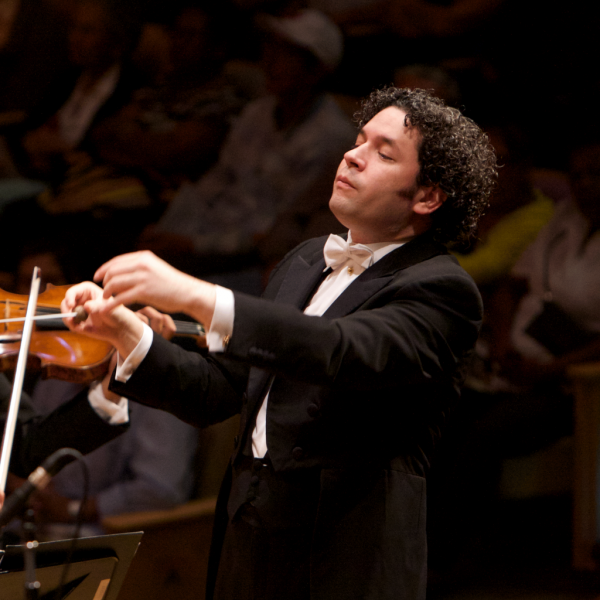When symphonic worlds collide: Dudamel closes Vienna Philharmonic stand with Ives, Tchaikovsky

Gustavo Dudamel conducted the Vienna Philharmonic in music of Ives and Tchaikovsky Sunday afternoon at Carnegie Hall.
“One laughs, the other weeps.” Brahms’s terse description of his two concert overtures (the Academic Festival and the Tragic) would also do for the two symphonies that the Vienna Philharmonic performed masterfully under Gustavo Dudamel Sunday afternoon at Carnegie Hall.
As Charles Ives described it, his Symphony No. 2 took a good-humored look back at his youth and “musical feelings of the Connecticut country around Redding and Danbury in the 1890s, the music of the country folk.” He crammed the piece with familiar hymns and patriotic songs, mixing them with snippets of Beethoven, Brahms, et al. in a jolly, bright-hued collage.
On the other hand, Tchaikovsky’s Symphony No. 4 was a breakthrough work for his confessional style, steeped in anguish, not only his best composition to that date but also the most raw and self-revealing. (Paradoxically, capturing so much misery in a symphony left the usually despondent composer ecstatic over what he’d accomplished.)
In fact, at Sunday’s concert it was not the experimentalist Ives but the concert-hall icon Tchaikovsky who came across as the wild man of music in Dudamel’s shirt-grabbing rendition. “Semi-barbaric” was the verdict of the New York Post critic after the Fourth Symphony’s local premiere in 1892 (according to Jack Sullivan’s informative program notes), and on Sunday one could still hear why.
Conversely, even though Ives is rightly remembered as a cantankerous Yankee and foe of everything that was “prissy” and conventional about classical music, he admired good playing when he heard it, and one imagines he would have gotten a kick out of the Continental sheen the Vienna players put on his all-American symphony.
That’s because the silken sound of the Vienna strings, with the support and bloom of the winds and brass, and the music’s effortless motion from one idea to the next, all served to point up how skillful Ives’s musical joinery was, even in this piece’s apparently chaotic moments. For this listener, mere tune-spotting—”Columbia, the Gem of the Ocean” here, “Bringing In the Sheaves” over there—soon gave way to enjoying how good everything sounded together.
Ives’s sudden excursions from hymn-like harmony into dissonance sounded not like barbaric yawps but simply a change of color to something more exotic and sensuous. Even the symphony’s notorious final chord, containing 11 of the 12 notes in the chromatic scale, was no sudden crash out of the blue but an intensification of the music leading up to it.
The music was so rich in incident that it was hard to tell where each of the five movements began and ended. In a section that could be titled “Tristan’s Sunday Morning in Danbury,” an old foursquare hymn got the chromatic treatment. A lone flute and cello took a stroll by the river, and time seemed to stop, but then it was off to the races—literally “Camptown Races,” in a rush of counterpoint.
The way Dudamel and the Vienna players honored the individuality of each of these moments while making the whole thing flow like a symphony was the signal achievement of Sunday’s performance.
In contrast, flow seemed to be the last thing on the conductor’s mind in Tchaikovsky’s symphony. The emphasis was not on this composer’s famously well-organized crescendos and climaxes—though these were expertly delivered—and even less on the piece’s all-too-familiar road map, but rather on restoring the element of surprise, the feeling that the symphony’s agitated, maybe even deranged protagonist might do or say just about anything.
The dull, depressive opening pages of Sunday’s performance prompted visions of a tedious three-quarters of an hour ahead. The little hopping second theme slowed to the point that one feared the performance would fall apart. But it was all a setup, the better to batter the listener with the white-hot rage of the development section and the devastating coda. Verdi never dropped a second-act curtain on a bigger catastrophe than Tchaikovsky and Dudamel showed us in those closing pages.
The Andantino offered a brief, melancholy respite: a wan little folk-style tune in a quavery oboe. Even while broadening occasionally for digressions and elaborations, Dudamel kept the music moving gently forward, giving the movement’s plaintive wind solos a gentle boost.
As later in his Sixth Symphony, Tchaikovsky inserted an exciting tour-de-force scherzo in the middle of a tragic piece. In Sunday’s performance, during the all-pizzicato outer sections, one had the sensation less of fast string plucking than of dark waves of resonant sound that surged up and ebbed. The trio for winds sparkled gaily, and the coda’s rapid-fire dialogue of winds and strings popped and fizzed.
The finale dived right in with more gaiety, but of a different kind. Even as the music moved along smartly, Dudamel made sure one heard the contrast between passages of frenzied celebration and the rather morose folk tune whose falling phrases seemed to mock all that forced jollity. The coda was the most manic of all, a veering orchestral storm that brought the audience to its feet at the end but offered little reassurance that all would be well in this symphony’s world.
Dudamel and his players closed the program on a more idyllic note with an encore, a suave, Viennese-tinted rendition of the waltz from Act I of Swan Lake.
The next event in Carnegie Hall’s International Festival of Orchestras will be the Bayerische Staatsoper, conducted by Kirill Petrenko, in a concert performance of Strauss’s Der Rosenkavalier 7 p.m. March 29. carnegiehall.org; 212-247-7800.


